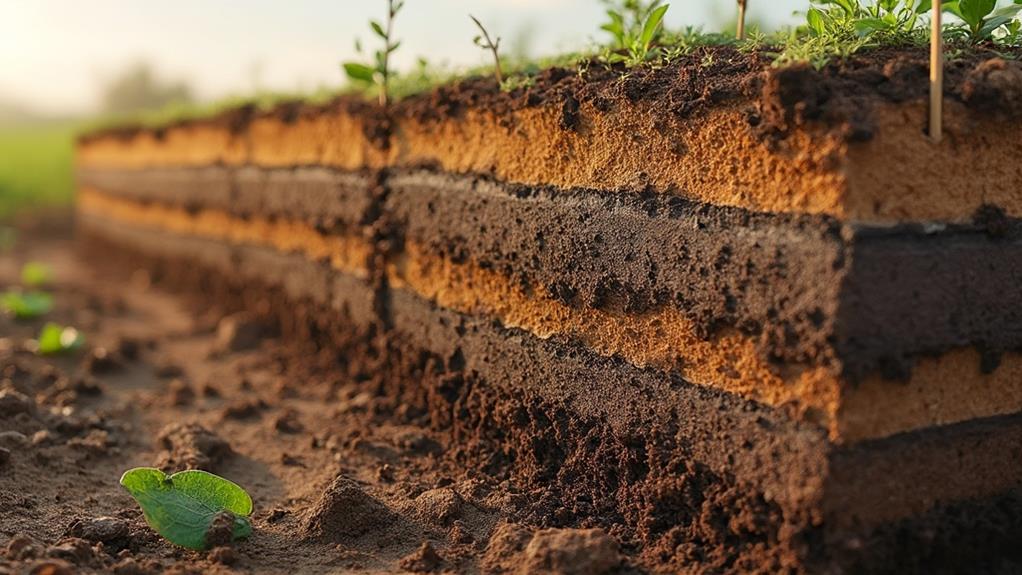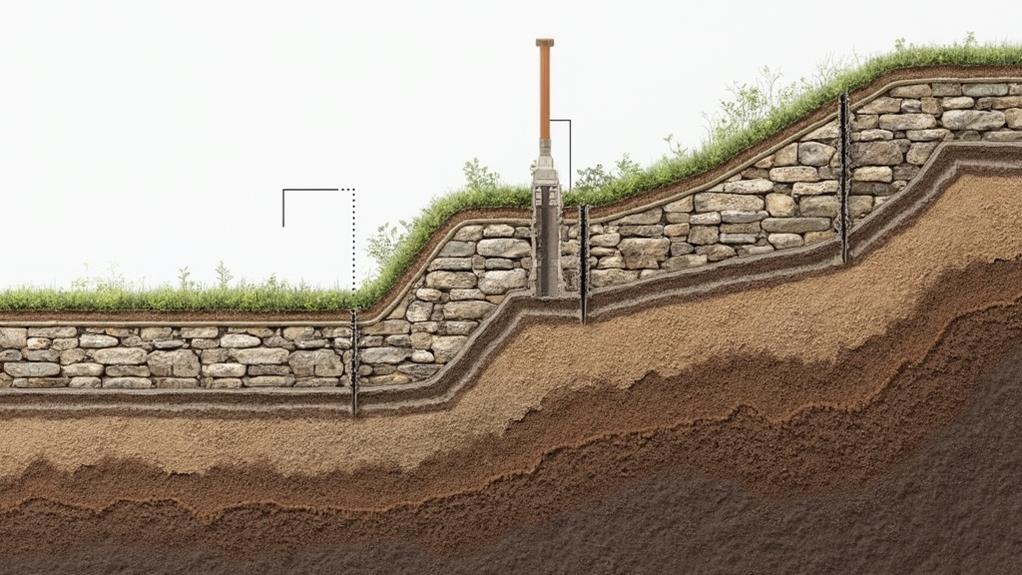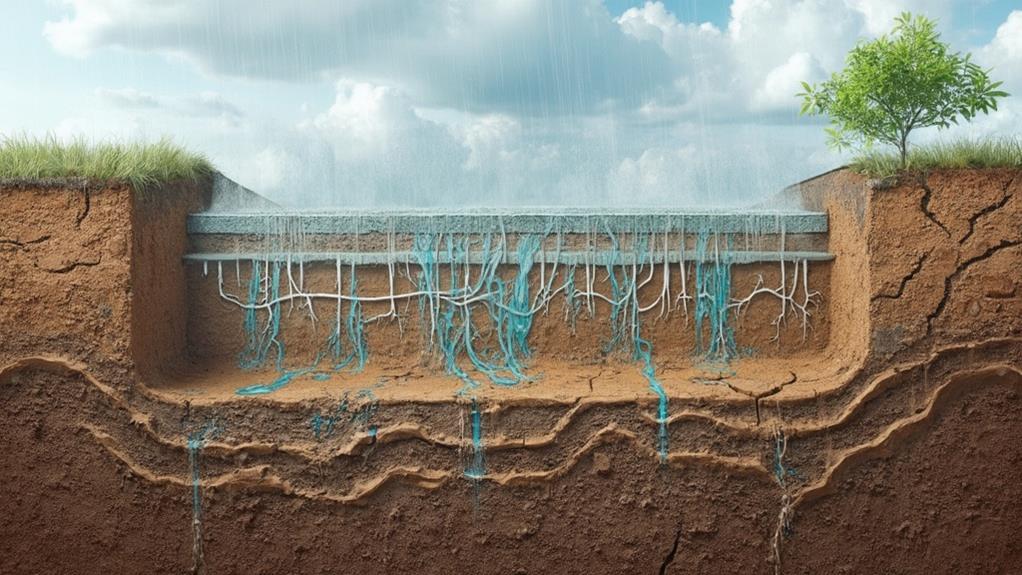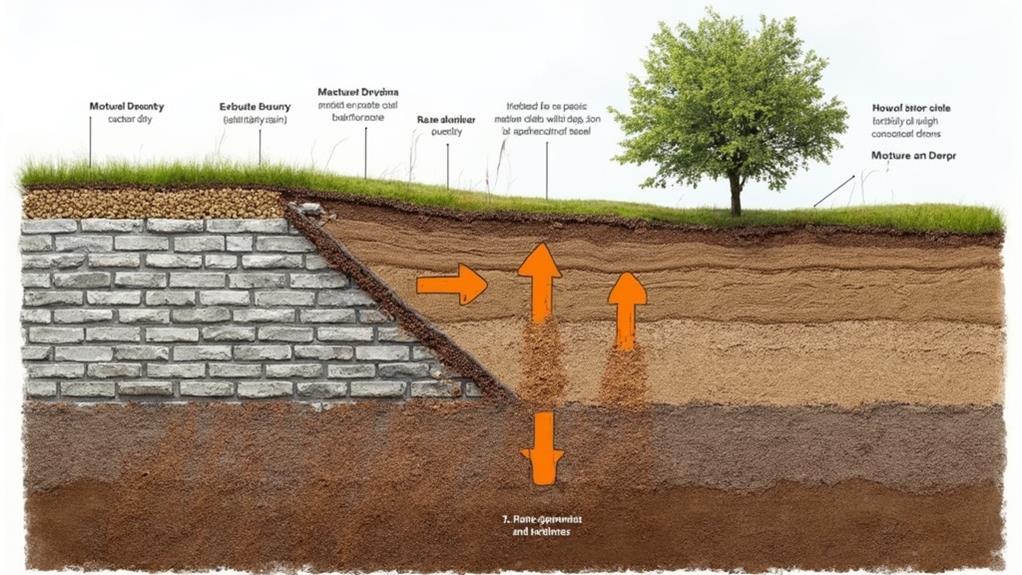Understanding soil mechanics is essential for retaining walls because it provides insight into soil behavior and strength, which are fundamental for guaranteeing the safety and stability of these structures. This field of study examines how soil compaction, cohesion, and internal friction impact lateral pressures, influencing the design and performance of retaining walls. Analyzing the soil-structure interaction helps predict potential displacements and failure modes, allowing for more robust and cost-effective solutions. Additionally, addressing external factors such as moisture, erosion, and wind pressure ensures that retaining walls can maintain structural integrity under various conditions, setting the foundation for further practical considerations.
Table of Contents
ToggleWalls Contractor Highlights
- Soil mechanics principles ensure retaining walls are designed to effectively withstand lateral soil pressures and maintain structural stability.
- Understanding soil strength factors like cohesion and internal friction is essential for accurate retaining wall design and performance.
- Soil-structure interaction studies help predict and mitigate forces that could compromise the safety and integrity of retaining walls.
- Knowledge of soil behavior, including compaction and permeability, guides the engineering of stable retaining wall foundations.
- Grasping soil mechanics aids in selecting suitable construction materials and techniques to prevent retaining wall failure.
Define Soil Mechanics

Soil mechanics, a cornerstone of geotechnical engineering, focuses on understanding the fundamental behaviors of soil, such as its ability to bear loads and provide stability. It encompasses the study of soil strength factors, including cohesion, internal friction, and compaction, which are essential in predicting how soil will react under stress.
Granite Company specialists apply these principles when designing and constructing retaining walls, ensuring they can withstand various weather conditions and provide long-lasting solutions for homeowners. In addition, the interaction between soil and structures, such as retaining walls, plays a pivotal role in the design and safety of civil engineering projects, necessitating a thorough analysis of the forces at play.
Basics of Soil Behavior
An essential branch of civil engineering, soil mechanics is pivotal in understanding the behavior of soil under various conditions. The study of soil behavior is foundational to constructing stable retaining walls, as these structures must account for the myriad interactions occurring within soil systems.
Soil, a heterogeneous mixture of minerals, organic matter, gases, and liquids, presents complexity in its behavior due to its varied composition. These constituents influence how soil reacts to stress, moisture, and different environmental factors, affecting its suitability for construction purposes.
Key aspects of soil behavior include its compaction, permeability, and consolidation. Compaction relates to the soil's ability to decrease in volume under pressure, which is indispensable for strength and stability. Permeability determines how water travels through soil pores, affecting drainage and erosion potential. Consolidation illustrates the transformation of soil structure over time due to the gradual expulsion of water when under sustained load. Each of these elements requires careful study and consideration, as inappropriate handling can lead to structural failures.
In the field of retaining wall construction, understanding soil behavior guarantees the walls are effectively designed to withstand lateral pressures, thereby enhancing their functionality and safety for communities.
Soil Strength Factors
Understanding soil strength is critical within the domain of soil mechanics, as it directly impacts the design and stability of structures like retaining walls. Soil strength refers to the ability of soil to withstand stresses without suffering failure, and it plays a decisive role in determining the dimensions and construction techniques applicable to retaining walls. Key soil strength factors include cohesion, angle of internal friction, and specific weight.
Cohesion is the measure of the intermolecular forces that bond soil particles, which is more prominent in clay soils due to their fine-grained nature. The angle of internal friction, derivable through shear testing, represents the soil's internal resistance to sliding along failure surfaces, heavily influencing the slope and stability of the retaining wall.
Specific weight, or unit weight, reflects the density of the soil and influences both earth pressures against the wall and the overall mass of the soil structure.
Professionals in geotechnical engineering meticulously evaluate these parameters through field testing and laboratory analysis. This substantiates that retaining walls complement the mechanical properties of the soil, fostering safety and longevity of these structures. Collectively, these soil strength factors guide engineers in designing retaining walls that integrate seamlessly with their geological context.
Soil-Structure Interaction
Often, the interaction between soil and structures is pivotal in the field of soil mechanics, as it encompasses the complex phenomena that occur at the interface of soil and engineered systems. In the context of retaining walls, this interaction is vital, as it involves understanding how forces, such as soil pressure and moisture content, influence the stability and integrity of the structure.
Soil-structure interaction (SSI) plays a significant role in determining the performance and longevity of retaining walls, ensuring they can safely support lateral earth pressures.
As soils and structures are inherently different in terms of material properties, the interaction becomes a sophisticated affair where both entities influence each other's behavior. For retaining walls, understanding soil-structure interaction requires a careful approach to investigating soil properties, such as cohesion, friction angle, and density, to predict and manage the forces at play.
Thorough analytical models and field studies are employed to evaluate how these factors contribute to soil movement and wall displacement under various conditions.
A detailed analysis of soil-structure interaction promotes community safety and maximizes the structural efficiency of retaining walls, reassuring those who rely on these systems for land support and infrastructure stability.
Benefits

The integration of retaining walls with a solid understanding of soil mechanics offers several critical benefits, including enhanced structural stability, which is pivotal in preventing catastrophic wall failures. By effectively analyzing and applying the principles of soil mechanics, engineers can optimize material usage, ensuring that structures are both robust and cost-effective over time.
Boulder retaining walls are particularly effective in this regard, as their sheer size and natural aspect provide both strength and aesthetic appeal. This strategic approach not only fortifies construction against environmental challenges but also achieves long-term cost efficiency by minimizing the need for frequent repairs and maintenance.
Enhanced Structural Stability
Retaining walls serve as an essential element in enhancing structural stability across various landscapes, providing indispensable support where the natural slope of the terrain poses challenges. By understanding soil mechanics, these structures can be precisely designed to counteract the lateral forces exerted by soil, thereby maintaining harmony between natural and human-made environments.
The benefits of well-designed retaining walls are manifold, ensuring safety and preventing soil erosion that could otherwise lead to instability. These structures can be tailored to suit specific site conditions, guaranteeing that aesthetic, and functional aspects are equally addressed.
Below are key advantages that retaining walls offer with respect to enhanced structural stability:
- Load Distribution: Efficiently designed retaining walls help in the even distribution of loads, minimizing stress on the underlying soil and mitigating potential structural failures.
- Slope Management: These walls effectively manage steep slopes, reducing the risk of land slippage and promoting sustainable land use.
- Hydrostatic Pressure Management: Proper drainage systems incorporated into retaining walls reduce hydrostatic pressure build-up, safeguarding the wall's integrity.
- Erosion Control: They act as barriers against soil erosion during heavy rains, allowing for better land preservation.
Embracing such features fosters a sense of security and community, protecting infrastructures and properties with expertise and foresight.
Prevents Wall Failures
Understanding the significance of preventive measures in retaining wall design is essential for minimizing the risk of structural failures. A well-designed retaining wall requires a robust knowledge of soil mechanics to anticipate and mitigate potential issues.
It is indispensable for engineers and builders to assess soil characteristics—such as cohesion, angle of repose, and shear strength—to guarantee that the wall can resist lateral earth pressures without succumbing to failure modes like sliding, overturning, or bearing capacity failure.
By employing a diligent analysis of soil conditions, professionals can implement design strategies that preemptively address these challenges. For instance, drainage solutions are vital in reducing hydrostatic pressure build-up behind the wall, a common cause of failure. This should involve incorporating granular backfill materials and confirming adequate drainage systems, such as weep holes or perforated pipes, which efficiently direct water away from the structure.
Retaining wall stability is not solely about meeting minimum standards but rather about fostering a design that harmoniously integrates with the surrounding environment. This emphasis on detailed planning and adaptation cultivates a sense of security within communities, engendering confidence that their landscapes will remain unyielding and secure amidst time, weather, and the elements.
Optimized Material Usage
Progressing from the strategic prevention of structural failures, an integral facet of retaining wall design can be found in the optimized usage of materials. Understanding soil mechanics enables engineers and builders to select and apply materials with precision, enhancing the wall's functionality while fostering efficiency and sustainability.
Optimized material usage presents several benefits that resonate with communities appreciating durability and resourcefulness in construction:
- Sustainability: Utilizing just enough material to achieve structural integrity reduces waste and environmental footprint, aligning with eco-friendly objectives cherished by environmentally-conscious communities.
- Performance: Tailoring materials to the specific soil conditions guarantees that the retaining walls achieve maximum stability. High-performing walls appeal to communities aiming for long-lasting infrastructure.
- Consistency: Ensuring materials are used consistently enhances predictability in structural behavior, a reassuring factor for individuals and communities valuing reliability.
- Adaptability: Knowledge of soil mechanics allows for material adaptation to diverse conditions, creating versatile solutions suitable for any geographical or environmental context, promoting a sense of belonging to diverse landscapes.
Long-Term Cost Efficiency
A well-considered approach to retaining wall construction not only guarantees immediate stability and aesthetic appeal but also contributes greatly to long-term cost efficiency. By integrating soil mechanics principles, one can design walls that effectively manage the natural pressures exerted by soil, thereby mitigating the risk of failure and the associated expenses. This proactive engineering makes certain that potential weaknesses are addressed during initial construction, rather than as costly, reactive repairs.
Furthermore, the strategic selection of materials and construction techniques plays a pivotal role in preventing water infiltration and erosion, both of which can prompt structural distress over time. By enhancing drainage and soil stabilization measures from the outset, ongoing maintenance costs are considerably reduced. Additionally, properly engineered retaining walls extend the life cycle of the surrounding landscape, safeguarding investments in landscaping and property enhancements.
Developers and homeowners alike find value in the assurance that their structures are built for longevity, demonstrating fiscal responsibility and craftsmanship. Understanding soil mechanics allows for informed decision-making that resonates with communities valuing thoughtful and sustainable development. Ultimately, these measures culminate in a retaining wall that not only performs its intended function but does so with enduring efficiency and reliability.
Weather Impact on Stability

In evaluating the stability of retaining walls, understanding the influence of weather is imperative, as rainwater can substantially increase erosion risks, the freeze-thaw cycle may induce fractures in materials, and wind pressure creates additional horizontal forces. The table below provides a concise overview of these weather impacts and their potential effects on structural integrity. By proactively considering these factors, engineers can better design and maintain retaining wall systems that withstand adverse weather conditions.
| Weather Element | Impact on Stability | Mitigation Strategies |
|---|---|---|
| Rainwater | Erosion risk | Effective drainage systems |
| Freeze-Thaw Cycle | Material fractures | Use of frost-resistant materials |
| Wind Pressure | Increased horizontal forces | Reinforcement and anchoring |
Rainwater Erosion Risks
While rainwater is a natural and essential element of our environment, its impact on retaining wall stability can be significant and potentially destructive. As rainwater infiltrates the soil behind retaining walls, it can lead to erosion, altering the structural integrity of the wall.
Understanding the risks posed by rainwater erosion is crucial for those involved in the construction and maintenance of retaining walls. Without careful consideration, the devastating effects of rainwater can compromise the safety and efficacy of these structures.
- Soil Saturation: Increased moisture content in soil reduces its shear strength, leading to potential sliding and toppling of walls.
- Hydrostatic Pressure: Accumulated water exerts pressure on the wall, potentially causing bulging or cracking.
- Soil Erosion: Runoff can wash away the soil at the base, undermining support and destabilizing the wall.
- Subsurface Drainage: Inadequate drainage systems fail to redirect water away, exacerbating erosion and pressure issues.
Freeze-Thaw Cycle Effects
Fluctuations in temperature, particularly during freeze-thaw cycles, pose significant challenges to the stability of retaining walls. As temperatures descend, water within the soil freezes, expanding by approximately 9%, which increases pressure within the soil mass. This pressure, exerted against the retaining structure, contributes to lateral wall displacement, which can compromise structural integrity.
When temperatures rise again, the thawing process leads to increased moisture and reduced soil cohesion, further destabilizing the wall.
One must consider the cumulative impact of these cycles over time. As the freeze-thaw process is repeated, soil structure weakens, and micro-cracks in the retaining wall material may develop, gradually exacerbating the deterioration. Understanding the soil composition and drainage properties becomes pivotal in constructing walls resilient to these conditions. Incorporating materials with high frost resistance for the retaining wall and ensuring adequate drainage are paramount actions in mitigating damage caused by freeze-thaw cycles.
Among a community of construction professionals, shared knowledge and foresight regarding these environmental challenges are indispensable. Collective expertise nurtures the development of innovative solutions that enhance the longevity and safety of retaining wall structures, ensuring they withstand the test of time and climate variability.
Wind Pressure Concerns
Wind's relentless force poses another challenge to the stability of retaining walls, particularly in areas prone to strong gusts. The impact of wind pressure can compromise the structural integrity of these walls if not duly considered during the design and construction phases. Wind loads must be meticulously calculated to guarantee the enduring performance of retaining walls.
Wall Design: Engineers must incorporate aerodynamic designs and materials that enhance resistance to lateral wind forces, thereby preventing structural failure.
Height and Location: Taller retaining walls in exposed, high-wind areas require additional reinforcement compared to those situated in sheltered conditions.
Soil Stabilization: Proper anchoring and the use of geosynthetic reinforcements can mitigate the risks posed by wind-induced pressure on the soil behind the wall.
Regular Maintenance: Periodic inspections and prompt repairs of any damage certify that retaining walls consistently withstand wind stresses over time.
Walls Contractor FAQ
How Does Soil Type Influence Retaining Wall Design?
The diversity of soil types directly impacts retaining wall design, influencing factors such as wall height, base width, and drainage requirements. By acknowledging these variances, engineers guarantee safety, stability, and longevity, fostering a sense of community and trust.
What Are Common Mistakes in Retaining Wall Construction?
Common mistakes in retaining wall construction include inadequate drainage, incorrect wall height, poor material selection, and insufficient reinforcement. Ensuring precise measurements, appropriate materials, and robust engineering principles fosters a sense of community reliability and cohesion in quality infrastructure.
How Often Should Retaining Walls Be Inspected for Soil-Related Issues?
Retaining walls should be inspected annually and after significant weather events to guarantee structural integrity. Regular inspections foster a shared responsibility and reassure communities that safety and functionality are maintained, aligning with collective goals for environmental and property stability.
Can Vegetation Affect the Stability of a Retaining Wall?
Vegetation can greatly impact the stability of a retaining wall. Root growth can either aid in soil reinforcement or exacerbate structural stress due to root expansion, highlighting the need for careful selection and management of plant species near retaining structures.
What Are Signs of a Failing Retaining Wall Due to Soil Problems?
Signs of a failing retaining wall due to soil issues include noticeable tilting, bulging, or cracking. Additionally, water seepage or increased soil erosion near the wall base may indicate underlying stability concerns. Monitoring these signs guarantees timely intervention.







